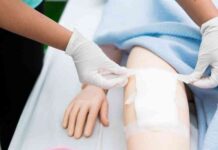The US was also protected by the omicron virus that struck this winter. Future spikes are likely to be much less disruptive.
Millions of Americans recognize the virus and have been trained to combat it if they come across omicron or any other variant.
Nearly half of all eligible Americans have had booster shots. There have been almost 80 million cases overall, and many more have not been reported. These factors are combined with others to calculate that 73% of Americans are immune to the dominant variant, omicron. This number could rise to 80% by March.
Experts agree that this will reduce or prevent new infections in those who are protected and also decrease the overall virus burden, potentially reducing new wave of infection. Experts agree that hospitals will be freed from overcrowded ICUs. Ali Mokdad, a professor of medical metrics sciences at the University of Washington, said, “We have changed.” “We’ve been exposed to the virus and know how to treat it.” The coronavirus, which is either the current or future variants of this deadly germ, remains dangerous. It still infects more than 130,000 Americans every day and kills more than 2000 people each day. Tens of millions remain at risk.
There will be more outbreaks. Under the harsh realities of new variants, declining immunity and the rejection by some Americans of vaccines, the notion of “herd immunity” to stop the virus has been lost.
The coronavirus is not new. It arrived in a country where no one’s immune system had ever seen it before two years ago. All 330 million people were immune-naive and therefore susceptible to infection.
Mokdad, who is a member of the Institute for Health Metrics and Evaluation, said that he was optimistic, even if there is a spike in summer. “Causes will go up but hospitalizations and death will not,” he added.
Many Americans are returning to pre-pandemic lives with varying degrees relief and caution.
Sarah Rixen (41), from Bismarck, North Dakota started singing again after a year of being absent. With omicron slowly fading, Rixen said that she feels more confident now than ever since the crisis started. “I will still wear a mask.”
Experts are trying to determine if this return to normal will last or if there is another setback.
Researchers are trying to address this issue by answering questions about the virus, vaccine and how our bodies react. How long does infection protection last? What percentage of mild infections have never been reported? How many people were infected, but didn’t show any symptoms?
They use data from countries like South Africa, Denmark, South Africa, Qatar and Britain to find clues.
Johns Hopkins Bloomberg School of Public Health scientists estimate that approximately three quarters of all Americans will be infected with omicron by end of surge.
Shaun Truelove, an epidemiologist at Johns Hopkins and a disease modeler, said that “We know it is a large proportion of the population.” “This is a variable thing, and we expect that in some areas the number of infected will be closer to one in two.”
This means that different areas or groups of people may have different levels of protection and risk. Virginia disease modelers think about their population as a series of different immunity levels.
According to the researchers, 45% of Virginians have high levels of immunity due to boosted vaccinations or vaccination plus an infection with omicron. Another 47% of Virginians have a weakened immune system; 7% are most at risk because they were not vaccinated or infected.
Bryan Lewis, a computational epidemiologist and leader of University of Virginia’s COVID-19 modeling group, stated that the vast majority of Virginians possess at least some immunity.
Lewis stated, “That’s going be a nice shield to armor for our population overall.” “If we get to very low cases rates, we can certainly ease back on some restrictions.”
Despite the fact that many people are better protected than others, it is still a problem. Even with the best population immunity estimates, 80 million Americans are still at risk. This is about the same number as the total confirmed infections in the U.S. during this pandemic.
Mokdad stated that “the 26% who could still receive omicron right away have to be very cautious.”
Andrew Pekosz is a Johns Hopkins Bloomberg School of Public Health virus researcher. He worries that some people, especially unvaccinated survivors of omicron, may feel reassured. He said that in a perfect world, people infected by omicron virus would be lined up to get vaccinated.
Estimating protection is not an exact science. As immunity wanes and new versions circulate, it’s difficult to estimate protection accurately. Individual protection can vary widely. It’s difficult to determine how many people are covered. The IHME model estimates that there is a wide range of Americans covered, ranging from 63% to 81%.
Mokdad stated that “We have reached a better position for the next months, but with waning immune we shouldn’t take this for granted.”







